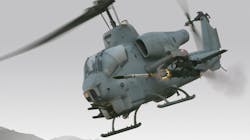The U.S. military is upgrading laser-guided rockets that enable fixed-wing aircraft, helicopters, and unmanned aerial vehicles (UAVs) to attack lightly armored vehicles, bunkers, field fortifications, cars, and trucks with electro-optical smart munitions.
Officials of the U.S. Naval Air Systems Command at Patuxent River Naval Air Station, Md., announced a $225 million order to the BAE Systems Electronic Systems segment in Hudson, N.H., to build an additional 9,999 WGU-59/B Advanced Precision Kill Weapon Systems (APKWS) II under full-rate Production Lot 7.
APKWS is an add-on kit that turns a standard unguided 2.75-inch 70-millimeter rocket into a precision laser-guided munition to give warfighters a low-cost surgical strike capability, BAE Systems officials say. Typically, the kit fits on the Hydra 70 fin-stabilized unguided air-to-ground rocket.
These new APKWS II weapons will upgrade the current 2.75-inch rocket system to a semi-active laser-guided precision weapon for the U.S. Army, Navy, Marine Corps, Air Force and the governments of Nigeria and the Netherlands. Last June BAE Systems won a $224.3 million Navy order for 10,185 APKWS II laser-guided rockets under production lot 7.
APKWS uses semi-active laser guidance technology to strike soft and lightly armored targets in confined areas, it has provided the U.S. Marine Corps with a 93 percent hit rate. It is smaller and less expensive than comparable laser-guided missiles like the AGM-114 Hellfire.
The APKWS laser-guided precision munition can fit aboard the U.S. Marine Corps UH-1Y, AH-1W, and AH-1Z helicopters, the experimental Bell 407GT helicopter, the U.S. Army AH-64 Apache attack helicopter, the Eurocopter Tiger, and the Navy MH-60 Seahawk helicopter.
The system also fits aboard fixed-wing aircraft such as the AV-8B Harrier II, F-16 jet fighter, and A-10 close-air-support jet.
In the future, the APKWS is under consideration for the Navy MQ-8 Fire Scout unmanned helicopter, OH-58 helicopter, V-22 tiltrotor, AH-6 Little Bird helicopter, the A-29 Super Tucano ground-attack aircraft, and the Navy F/A-18E/F fighter-bomber.
The APKWS-equipped rocket is slightly longer than six feet, 2.75 inches in diameter, has a wingspan of 9.55 inches, and weighs 32 pounds. It uses the Hydra 70 impact-detonating, air-burst, or standoff warheads. The laser munition can hit targets as far away as three miles, flies at speeds of 2,200 miles per hour, and costs $30,000 apiece.
On this order BAE Systems will do the work in Hudson, N.H., and Austin, Texas, and should be finished by September 2020. For more information contact BAE Systems Electronic Systems online at www.baesystems.com, or Naval Air Systems Command at www.navair.navy.mil.

